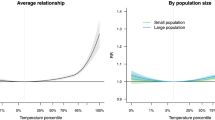Abstract
Sound statistical methodology for assessing environmental justice is clearly needed, but has been slow to develop. In this paper, we investigate the use of hierarchical Bayesian methods for combining disparate sources of environmental data featuring complex correlations over both space and time. After a brief review of the Bayesian approach and its specific application to disease mapping problems, we illustrate two case studies. The first of these investigates the effect of a certain nuclear fuel reprocessing facility in Ohio on the lung cancer rates in the counties that surround it, while the second concerns the relation between air quality (especially in terms of ambient ozone levels) and pediatric emergency room visits due to asthma in the Atlanta metro area. We close by summarizing the method's implications for environmental justice, as well as future methodological and applied work.
Similar content being viewed by others
Author information
Authors and Affiliations
Corresponding author
Rights and permissions
About this article
Cite this article
CARLIN, B., XIA, H. Assessing environmental justice using Bayesian hierarchical models: two case studies. J Expo Sci Environ Epidemiol 9, 66–78 (1999). https://doi.org/10.1038/sj.jea.7500027
Accepted:
Published:
Issue Date:
DOI: https://doi.org/10.1038/sj.jea.7500027
- Springer Nature America, Inc.




